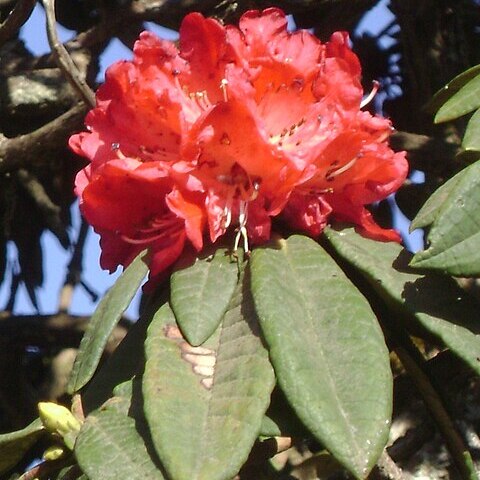Trees, usually evergreen, (1–)5–20(–30) m tall; trunk well-defined; bark gray-brownish, exfoliating into thin and small irregular flakes; young shoots stout, with distinct leaf traces, densely grayish tomentose, glabrescent. Winter buds ovoid, 10–12 × 5–6 mm, puberulent. Petiole 10–25 mm with dense fawn indumentum intermixed with glands, sometimes glabrescent; leaf blade leathery, oblong-lanceolate or oblong-oblanceolate, 6–15 × 2–4.5 cm; base cuneate or ± rounded; margin revolute; apex acuminate or acute; abaxial surface with indumentum 1-or 2-layered, densely compacted, white to fawn tomentose, sometimes with loosely floccose brown upper layer, hairs dendroid, glabrescent; adaxial surface reticulate to bullate, glabrous; midrib deeply impressed adaxially; lateral veins 15–26-paired. Inflorescence dense, ca. 20-flowered, rachis 10–15 mm, tomentose. Pedicel ca. 0.9 cm, pilose, glandular; calyx lobes 5, 1–2 mm, small, triangular, sparsely glandular and hairy; corolla tubular-campanulate, pink to deeply crimson, rarely white, 3.5–4 cm, with 5 black-blotched basal nectar pouches and dark flecks; lobes 5, 1.2–1.7 cm, apex emarginate; stamens 10, unequal, 1.7–2.7 cm, filaments glabrous; ovary conoid, 4–6 mm, white-tomentose, sometimes also glandular; style ca. 3.3 cm, glabrous. Capsule cylindric, ca. 30 × 6 mm. Fl. May, fr. Aug.
More
A small evergreen tree. It can be 1-8-15 m high. It can spread 4.5 m high. The leaves have stalks. The leaves are crowded towards the ends of the branches. Leaves are 4.5-16 cm long by 1.5-6 cm wide. They are oblong to sword shaped and narrow at both ends. They are silvery underneath. The flowers are red, white or pink. The flowers are crowded in large round heads. There are 10 stamens. The fruit capsule is 1.5-2 cm long. It has ribs along it.
A tropical and subtropical plant. It grows in the highlands of Vietnam between 2,550 and 3,000 m altitude. In Nepal it grows between 1400-3300 m altitude. It grows on hillsides in mixed oak forests. It is native to the Himalayas. It suits hardiness zones 7-9. Arboretum Tasmania.
More
Forests and shrubberies with Pieris ovalifolia and Quercus incana; at elevations from 1,500-3,600 metres.


